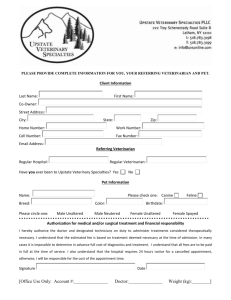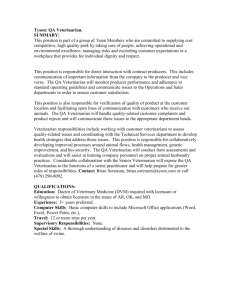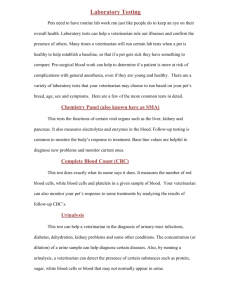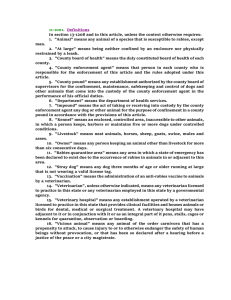Test Your Knowledge of Legal Drug Use in Dairy Cattle
advertisement
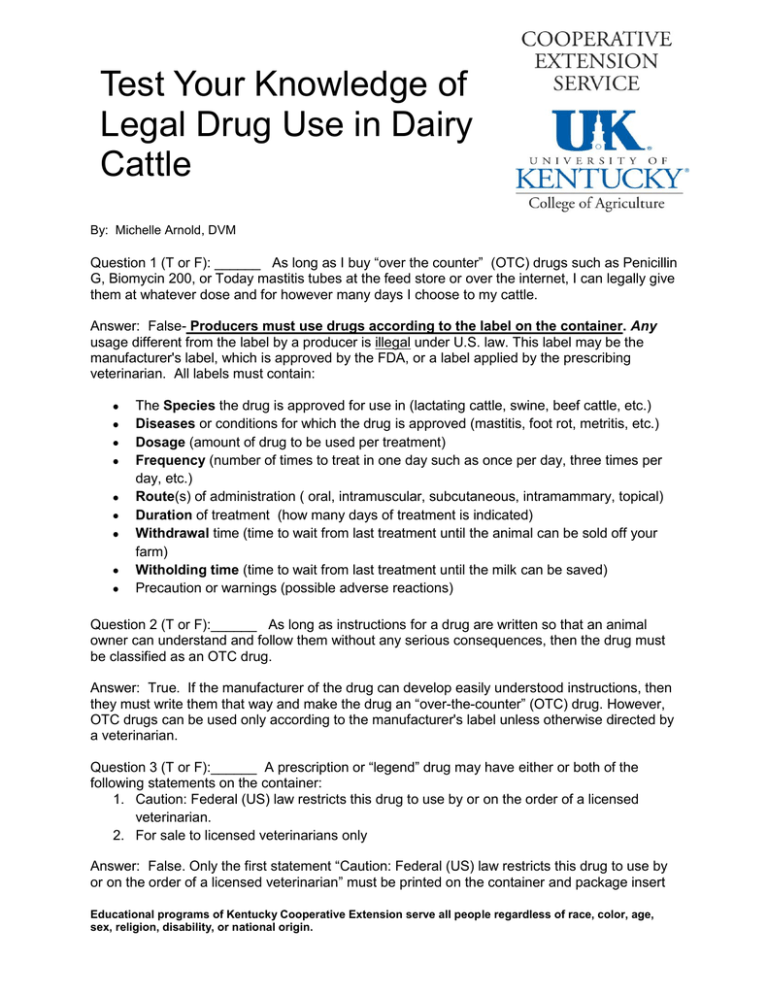
Test Your Knowledge of Legal Drug Use in Dairy Cattle By: Michelle Arnold, DVM Question 1 (T or F): ______ As long as I buy “over the counter” (OTC) drugs such as Penicillin G, Biomycin 200, or Today mastitis tubes at the feed store or over the internet, I can legally give them at whatever dose and for however many days I choose to my cattle. Answer: False- Producers must use drugs according to the label on the container. Any usage different from the label by a producer is illegal under U.S. law. This label may be the manufacturer's label, which is approved by the FDA, or a label applied by the prescribing veterinarian. All labels must contain: The Species the drug is approved for use in (lactating cattle, swine, beef cattle, etc.) Diseases or conditions for which the drug is approved (mastitis, foot rot, metritis, etc.) Dosage (amount of drug to be used per treatment) Frequency (number of times to treat in one day such as once per day, three times per day, etc.) Route(s) of administration ( oral, intramuscular, subcutaneous, intramammary, topical) Duration of treatment (how many days of treatment is indicated) Withdrawal time (time to wait from last treatment until the animal can be sold off your farm) Witholding time (time to wait from last treatment until the milk can be saved) Precaution or warnings (possible adverse reactions) Question 2 (T or F):______ As long as instructions for a drug are written so that an animal owner can understand and follow them without any serious consequences, then the drug must be classified as an OTC drug. Answer: True. If the manufacturer of the drug can develop easily understood instructions, then they must write them that way and make the drug an “over-the-counter” (OTC) drug. However, OTC drugs can be used only according to the manufacturer's label unless otherwise directed by a veterinarian. Question 3 (T or F):______ A prescription or “legend” drug may have either or both of the following statements on the container: 1. Caution: Federal (US) law restricts this drug to use by or on the order of a licensed veterinarian. 2. For sale to licensed veterinarians only Answer: False. Only the first statement “Caution: Federal (US) law restricts this drug to use by or on the order of a licensed veterinarian” must be printed on the container and package insert Educational programs of Kentucky Cooperative Extension serve all people regardless of race, color, age, sex, religion, disability, or national origin. Test Your Knowledge of Legal Drug Use in Dairy Cattle in those exact words to be a prescription drug. These drugs can only be purchased and used under the guidance of a licensed veterinarian and the producer can use these drugs only according to the label on the drug container. Question 4 (T or F):_____ If a veterinarian has been on my farm in the last year, he or she is required to write a prescription for me if I request it. Answer: False. Prescription drugs can only be purchased and used if a valid veterinary-clientpatient relationship (VCPR) exists between the producer and prescribing veterinarian. A valid VCPR exists when all of the three following conditions have been met: 1. The veterinarian has assumed the responsibility for making clinical judgments regarding the health of animals and the need for medical treatment. Equally important-the client has agreed to follow the veterinarian's instructions. 2. The veterinarian has sufficient knowledge of the animals to make at least a preliminary diagnosis. This means that the veterinarian must have recently seen and is personally acquainted with the keeping and care of the animals. This is accomplished by either examination of individual animal(s) or medically appropriate and timely visits to the premises of the animal(s). 3. The veterinarian is readily available for follow-up evaluation or has arranged for emergency coverage in case of adverse reactions or failure of the treatment regimen. Ultimately the veterinarian must decide what constitutes a valid VCPR for his or her practice and whether or not to write prescriptions if requested to do so. Most food animal veterinarians maintain a large inventory of prescription medications that are available for purchase by producers. Question 5 (T or F): ____ A veterinarian can use or prescribe the use of any drug “off label” or “extra-label” in food animals as long as he/she applies a new label specifically explaining directions for use and slaughter withdrawal time. Answer: False. According to the FDA Animal Medicinal Use Clarification Act (AMDUCA), for the veterinarian to use or to prescribe the use of any drug "extra-label" in food animals, the following criteria must be met: The drug is an FDA approved animal (NADA) or human drug. Off label can only be used when an animal's health is threatened or the animal is suffering. Off label can only be used for therapeutic purposes or therapeutic preventive medicine, not for purposes of production or reproduction. The veterinarian must make a careful diagnosis or evaluation of the condition for which the drug will be used. If an approved drug exists, the veterinarian must decide that drug will not work (clinically ineffective) in this situation. The producer must carefully maintain treatment records, the identity of the treated animals, and the condition treated for at least 2 years. The veterinarian must establish an extended withdrawal period supported by appropriate scientific information. Educational programs of Kentucky Cooperative Extension serve all people regardless of race, color, age, sex, religion, disability, or national origin. Test Your Knowledge of Legal Drug Use in Dairy Cattle Veterinarians cannot prescribe drugs for extra-label use in or on feed. Certain drugs (for example-enrofloxacin (Baytril 100®) are only labeled for non-lactating dairy replacement animals for pneumonia. Any extra-label use is prohibited. Animal drugs are carefully regulated by the FDA to keep the food supply protected from residues in milk (and meat). It is important to keep our food supply free of drugs because of possible adverse reactions in humans who consume the tainted milk or meat. The Grade “A” Pasteurized Milk Ordinance requires that all bulk milk tankers be sampled and analyzed for beta-lactam drug residues before the milk is processed and rejected for human consumption if positive. Additional screening for other types of drugs in milk is performed through a random sampling program. At the packing plant, the USDA Food Safety Inspection Service (FSIS) conducts tests for chemicals-including antibiotics and various other drugs, pesticides, and environmental chemicals-in meat, poultry, and egg products destined for human consumption. With this information, FSIS maintains a “Same Source Supplier-Residue Violator List” (accessible via the internet) that contains the names and addresses of producers who have more than one meat residue violation in a 12 month period. When a farm is added to this list, livestock originating from that farm will undergo more scrutiny and testing when harvested. Warning Letters are issued for violations of regulatory significance that may lead to enforcement action if not promptly and adequately corrected. A Warning Letter is the agency's principal means of achieving prompt voluntary compliance with the Federal Food, Drug, and Cosmetic Act. Warning Letters (including the name and address of the producer and the specific violation) are posted on FDA’s website. Perhaps more importantly, it has been proposed to randomly sample milk at the farm for 27 different drug residues from dairies which have had a tissue residue violation in the past three years. Bottom Line: Read and follow the label directions on all medications-it’s the law! Educational programs of Kentucky Cooperative Extension serve all people regardless of race, color, age, sex, religion, disability, or national origin.
